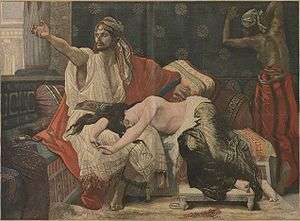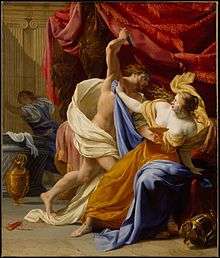Tamar (daughter of David)

Tamar (Hebrew: תָּמָר, Modern tamar, Tiberian tāmār) is a person in 2 Samuel in the Hebrew Bible. She was the daughter of King David, and sister of Absalom. Her mother was Maacah, daughter of Talmai, king of Geshur. In 2 Samuel 13, she is raped by her half-brother Amnon.
Background
Michael D. Coogan attributes the placement of the rape of Tamar narrative, coming soon after the Bathsheba narrative, as a way for the narrator to compare Amnon to David. As David wronged Bathsheba, so too will Amnon wrong Tamar, "like father like son."[1] Mark Gray, however, disagrees with this position, and argues that "the rape of Tamar is an act of such horrific defilement that it is marked off as distinct from David's encounter with Bathsheba."[2]
According to 2 Samuel 13:18, Tamar had a "richly ornamented robe" (NIV). Adrien Bledstein connects this to Joseph's coat of many colors, and concludes that Tamar was a priestess, healer and "mistress of dreams".[3]
Rape

Amnon rapes Tamar (2 Samuel 13:1-14)
According to the Bible, Amnon over time developed such strong feelings for his half-sister that he became ill over his lust for her. Amnon had a friend and counselor named Jonadab who, being said to be not only a "crafty man" but also Amnon's cousin,[4] advised that Amnon pretend to be sick. Amnon did what was suggested, pretended to be sick and asked Tamar to prepare him food. He then asked her to have intercourse with him. When Tamar desperately tried to dissuade him, requesting him as a last argument to ask their father for her hand in marriage, Amnon raped her.
Immediate aftermath (2 Samuel 13:15-22)
After the rape, Amnon was overwhelmed by hatred for Tamar and he sent her home. Tamar expressed her grief by tearing her robe and marking her forehead with ashes. She went to her full brother Absalom, who attempted to comfort her and took her into his home where she remained a "desolate woman." When King David, Tamar's father, heard of her rape, he was angered but did nothing. According to the Dead Sea Scrolls and Greek version of 2 Samuel 13:21, "... he did not punish his son Amnon, because he loved him, for he was his firstborn."[5]
Absalom murders Amnon (2 Samuel 13:23-29)
Absalom, who hated his half-brother Amnon for his rape of Tamar, waited for two years and then had Amnon murdered.
Assessment
Mary J. Evans describes Tamar as a "beautiful, good-hearted obedient, righteous daughter who is totally destroyed by her family."[6] After the rape, Amnon attempted to send Tamar away. She responded "No, my brother; for this wrong in sending me away is greater than the other that you did to me" (2 Samuel 13:15-16). This response refers to Deuteronomy 22:28 which states that a man who rapes a virgin must marry her. In Biblical law, it was unlawful for a man to have intercourse with his sister; Kyle McCarter suggests that either the laws are not in effect at this time or they will be overlooked by David, or they do not apply to the royal family.[7] Michael D. Coogan, in his section on women in 2 Samuel, describes Tamar as a "passive figure" whose story is "narrated with considerable pathos." Coogan also points out the poignancy of the image at the end of the narrative story where Tamar is left as a "desolate woman in her brother Absalom's house" (2 Samuel 13:20). This ending verse about Tamar is meant to make the reader feel compassion and pity for her.[1]
Literary references
- Georg Christian Lehms, Des israelitischen Printzens Absolons und seiner Prinzcessin Schwester Thamar Staats- Lebens- und Helden-Geschichte (The Heroic Life and History of the Israelite Prince Absolom and his Princess Sister Tamar), novel in German published in Nuremberg, 1710
- The Spanish poet Federico García Lorca wrote a poem about Amnon's rape of his sister Tamar, included in Lorca's 1928 poetry collection Romancero Gitano (translated as Gypsy Ballads). Lorca's version is considerably different from the Biblical original - Amnon is depicted as being overcome by a sudden uncontrollable passion, with none of the cynical planning and premeditation of the original story. He assaults and rapes Tamar and then flees into the night on his horse, with archers shooting at him from the walls - whereupon King David cuts the strings of his harp.
- The Rape of Tamar, novel by Dan Jacobson (ISBN 1-84232-139-0)
- The Death of Amnon poem by Elizabeth Hands
- In Stefan Heym's 1973 "The King David Report",[8] the East German writer's wry depiction of a court historian writing an "authorized" history of King David's reign, a chapter is devoted to the protagonist's interview with Tamar - who is described as having gone insane as a result of her traumatic experience.
References
- 1 2 Coogan, Michael D. A Brief Introduction to the Old Testament.. (Oxford University Press: 2009), 212.
- ↑ Gray, Mark (1998). "Amnon: A Chip off the Old Block? Rhetorical Strategy in 2 Samuel 13:7-15: The Rape of Tamar and the Humiliation of the Poor". JSOT. 77: 40.
- ↑ Bledstein, Adrien Janis, "Tamar and the Coat of Many Colors". In Brenner, Athalya (ed.), A Feminist Companion to Samuel & Kings [Second Series] (Sheffield: Sheffield Academic Press, 2000).
- ↑ Hill, Andrew E. (1987). "A Jonadab Connection in the Absalom Conspiracy?" (PDF). JETS. Retrieved 12 November 2014.
- ↑ http://www.biblegateway.com/passage/?search=2+Samuel+13&version=NLT#fen-NLT-8315d
- ↑ Mary J. Evans, "Women," in Bill T. Arnold and H. G. M. Williamson (eds.), Dictionary of the Old Testament Historical Books (Downers Grove: IVP, 2005), 994.
- ↑ P. Kyle McCarter Jr, "Second Samuel Commentary," Harold W. Attridge (eds.), Harper Collins Study Bible; Including Apocryphal Deuterocanonical Books Student Edition NRSV (New York: Harper One, 2006), 454.
- ↑ Danny Yee (1994). "Danny Yee's Book Reviews". Retrieved September 20, 2010.
review
External links
| Wikimedia Commons has media related to Tamar (2 Samuel). |